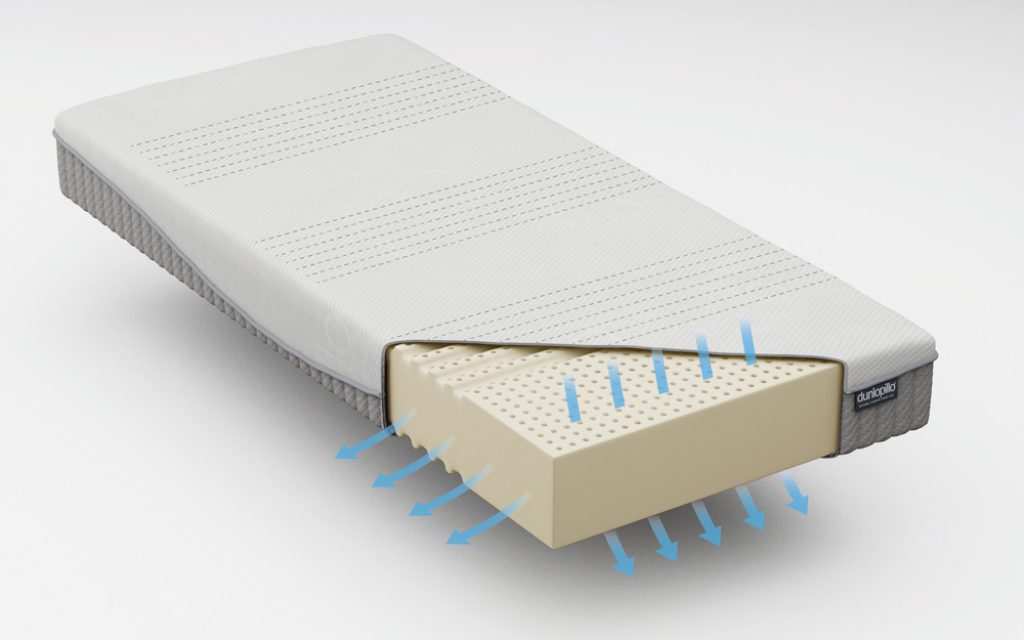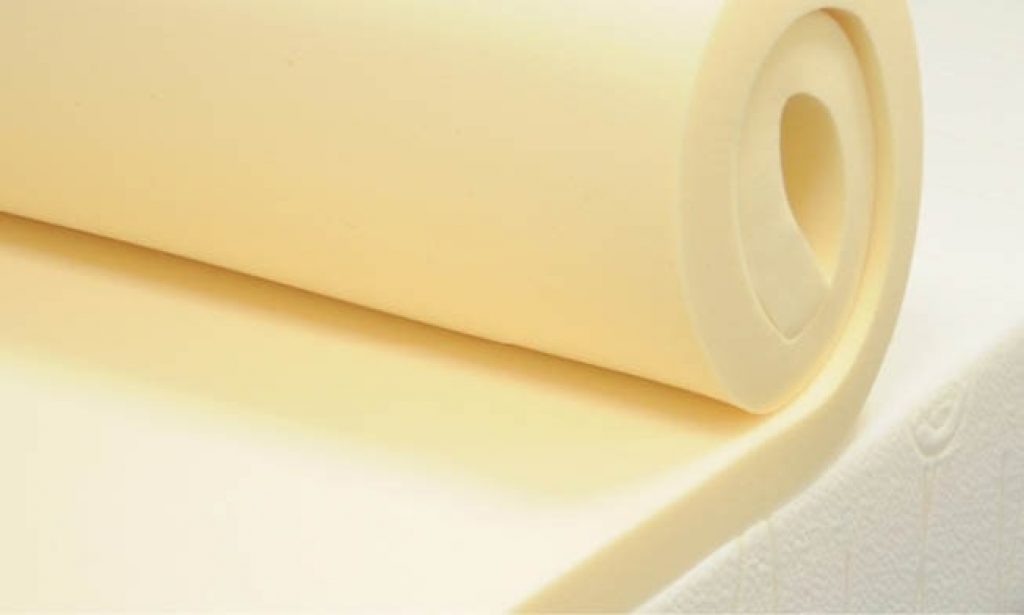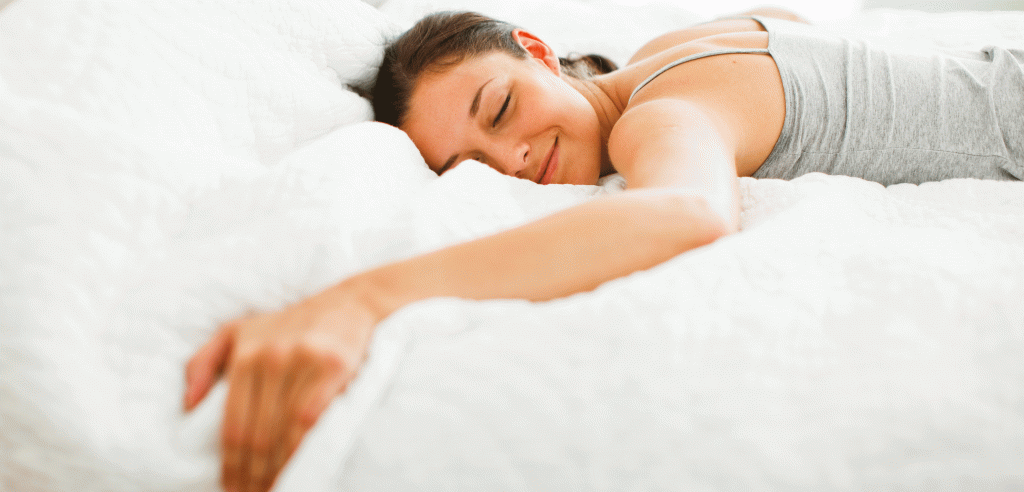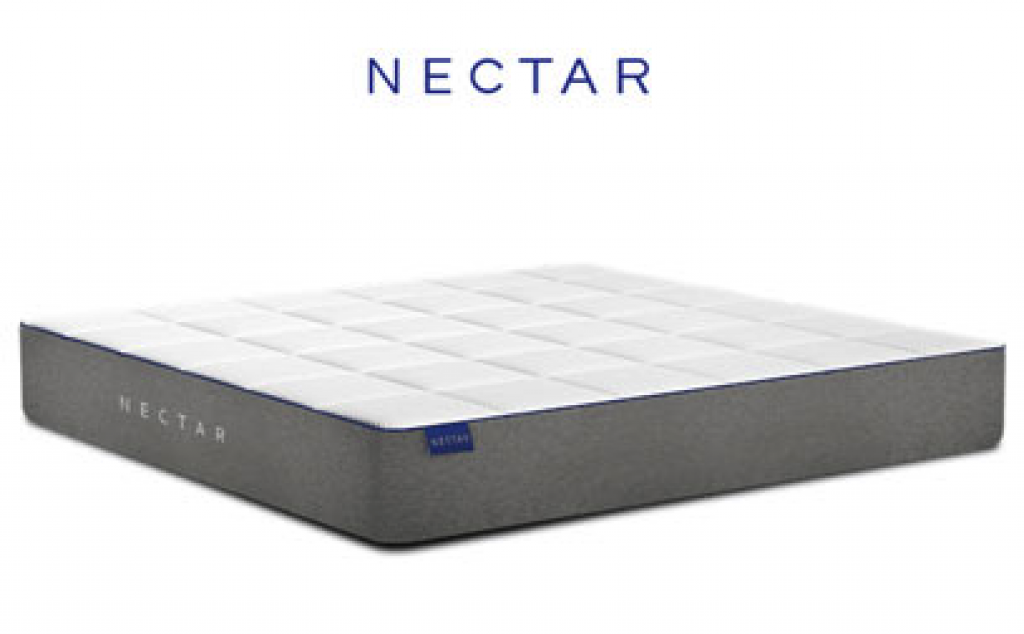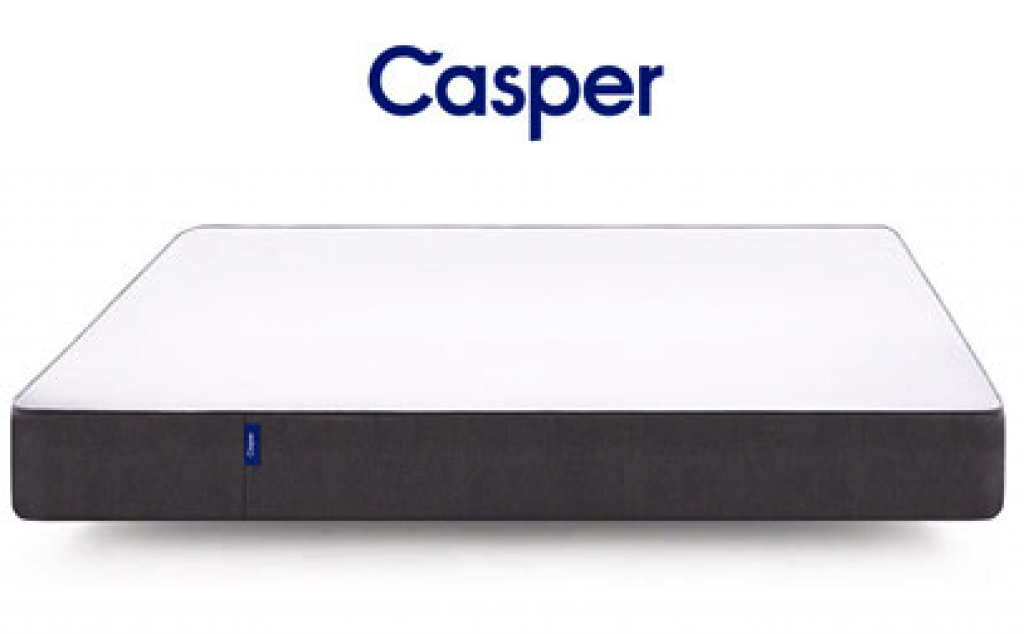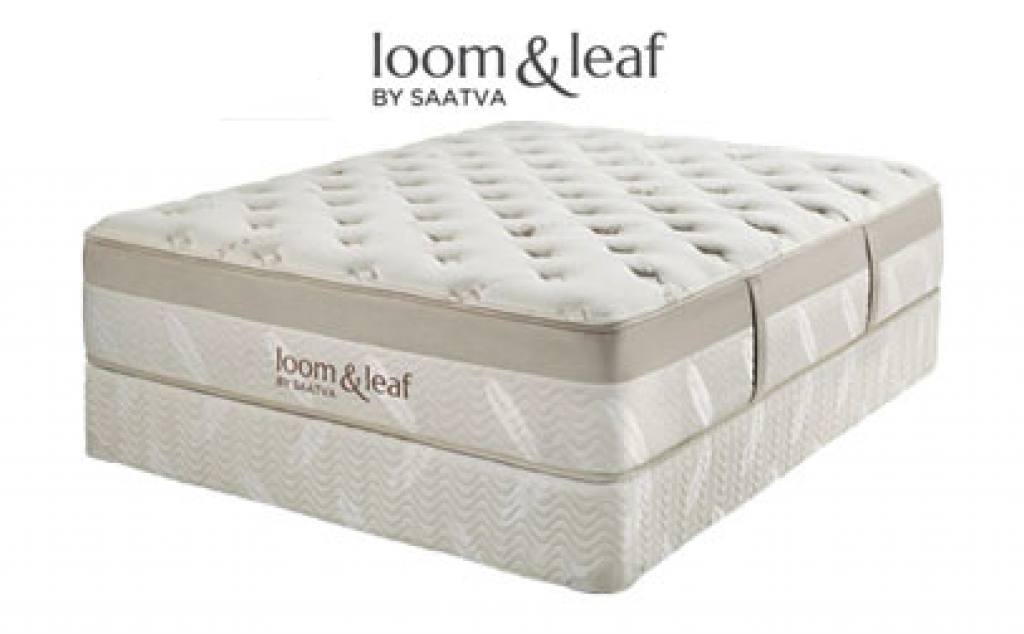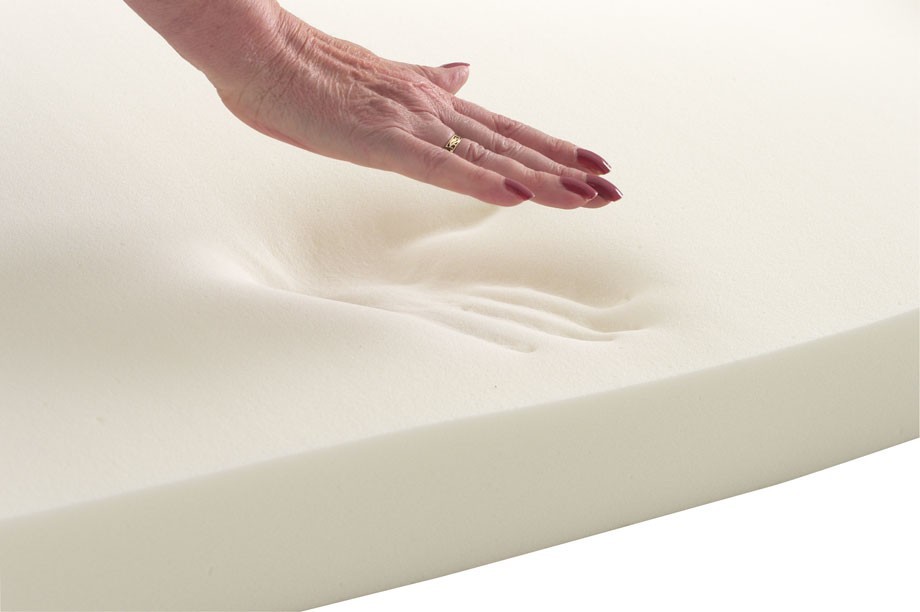
Memory foam is quite a controversial material! It is 100% manmade and has unique features that can make you either love it or hate it.
First, memory foam is also known as viscoelastic, because it combines viscosity and elasticity. The surface behaves like a viscous solid when you apply pressure and heat, and it changes shape accordingly. However, when those elements are removed, the surface will slowly spring back to its initial shape (hence, the ‘memory foam’ name).
Because of these properties, a memory foam mattress can’t be appreciated in the first five minutes you’ve laid down on the surface. The bed needs to absorb your body heat in order to become softer and contour to your curves. This is also the reason why, when it’s cold in the room, a memory design mattress can seem firm and unyielding.
However, once the surface gets used to your shape, such a bed is a good fit for most sleep positions. Because it is both soft and supporting, it will accommodate both side and back sleepers, but it’s also a good match for stomach sleepers who enjoy a softer surface.
Since shopping for a highest quality memory foam mattress can be a bit confusing, with so many features, materials, and improvements available, we took the liberty of choosing some of the best designs on the market.
All about Memory Foam
The History
Before we dive into its characteristics, let’s take a look at how memory foams actually came to be.
It all started in 1966, when NASA engineers decided to create a material that will make their astronauts and pilots more comfortable during long flights. The idea was to create something that adapts to each shape sitting on it, which is why the result is responsive to both pressure and temperature.
So, what’s now known as memory foams or viscoelastic, it was initially named “slow spring back material”. The material is created by combining gas and a polymer matrix (which is why memory mattresses need off-gassing), and the resulted surface is moving to accommodate your needs.
Once the inventors understood its potential, they started commercializing it. They started by including it in medical equipment and moved up to sports equipment (liners for helmets). The material was then released to the public domain by NASA in 1980 and by 1981 we had the first memory foam mattress.
The manufacturing process was improved and nowadays, there are a plethora of companies selling this type of bedding. However, memory foams are versatile, and it’s easy to tamper with the structure, to reduce the cost of production. This has led to the production of low-quality designs, which brought a bit of a downfall to viscoelastic’s popularity.
Responsiveness
One of the features that matter the most in memory foams is responsiveness. This is calculated as the amount of time it takes the surface to regain its initial shape once pressure and heat have been removed.
Responsiveness is influenced by density and the type of pressure you apply. For instance, if you jump on the bed, the surface won’t soften that much on impact, but if you lay on it, preparing for sleep, the bed will soften and mold after your curves in about 5 to 10 minutes.
Of course, responsiveness is also influenced by the environmental temperature. In a cold room, the mattress will take a bit longer to soften up and take onto your curves, but in a heated room, the mattress will be less viscous, getting even more fluid as you add your body heat.
Now, when you select such a bed, it’s important to pay attention to the material’s density. This feature will determine the speed of your mattress response when you change positions. Low density means the mattress will move slower, producing that ‘stuck in sand’ sensation many people dread. However, a high density, traditional, viscoelastic design will move faster to follow your position changes during the night.
Heat and Cooling
Heat
Now, if you know anything about viscoelastic, you know that it has a tendency to overheat. This happens because it has a dense structure that traps heat inside and releases it gradually during the night. Furthermore, memory foams are actually polyurethane, and this material is not known for its heat regulating properties.
While some sleepers prefer a mattress that sleeps hot, especially if they live in colder climates, others are not that crazy about this feature. During summer time, sleeping on a bed with memory may be more tormenting than comfortable.
In time, manufacturers managed to solve this problem as well, but they had to change the traditional memory foam feel a bit. The best solution with this material is represented by cooling gel infusions which open the cell structure of the surface and allow air to move up and down through the surface just as needed.
Cooling
When it comes to delivering a memory foam experience without the heat problem, there are two types of materials that do the job extremely well:
- Air Cool Material.
- Gel foams.
The Air Cool technique is based on a structure with a layered design with materials of different densities. Some of the layers are ventilated (meaning they have small holes drilled in the surface to allow the air to move), while some are infused with various materials like charcoal or copper. These materials absorb humidity and quicken the heat dissipation process.
Gel foams are less complicated and can be used as part of a more complex structure (usually a hybrid design). Now, there are two ways the foam can be infused with cooling gel: either the beads are dispersed through the surface or the gel is inserted as a thin layer, at the core. Regardless of method, the gel acts by opening the cell structure and by absorbing and cooling the hot air at the surface.
One of a Kind Memory Foam Feel
Now let’s talk a bit about the controversies this material has stirred over the time. First, the memory foam feel is quite unique because the foam is both soft and firm and provides contouring and support. It is indeed one of the best materials to consider for your comfort in bed. However, because it is made with petroleum-based products and has a characteristic smell (that goes away in about 24h after unboxing), there are people who avoid it.
To avoid such negative opinions, manufacturers everywhere use gels and other cooling methods (see the explanations above).
Another controversy happens around the unique feel, which is a bit like rolling around in the sand. Still, if the material is not dense enough, it can feel like being stuck in quicksand, as the foam will move with a bit of a lag. This feature can interrupt your REM sleep and can create an opposite effect to the one you want.
Things to Consider About This Type of Bed
You Will Love This Material If
- You like a soft surface – Viscoelastic is a combination of soft and firm, but it leads more towards soft. Of course, if it is used just for the top layer, with other types of foam underneath, the design can be medium-firm, but an all-memory-foam design will be more soft than firm.
- You share the bed with a partner – There’s nothing worse than awakening from the sweetest slumber by your partner’s tossing and turning. So, if you share a bed with a restless partner, memory foam is the best solution! This material absorbs most of the energy created when one of the partners changes position and doesn’t transmit it through the entire surface (like an innerspring would).
- You enjoy a contouring surface – One of the features that made viscoelastic famous is the contouring. When the surface adapts to your weight and temperature, indentations will be created on the surface to adjust the bed to your unique shape. Basically, the surface sinks a bit where your heavy areas rest.
- Side sleeping is your favorite position – Due to its contouring feature, the viscoelastic design is a fantastic choice for side sleepers! When you sleep on the side, you need a bed that will not create pressure points between your shoulders and hips (the most affected areas). Now, because viscoelastic permits sinkage, your spine will be almost perfectly aligned in a horizontal plane, creating a comfortable sleeping place for you.
- You like a hot mattress – As we mentioned already, traditional viscoelastic tends to sleep hot. However, if you like this feature or live in a cold environment, this may be just right! After all, who wouldn’t love to sit on a toasty, cozy surface when outside is snowing?
You Will Not Love This Material If
- Natural fibers are very important for you – Latex, wool, and feathers are amazing materials indeed, and if this is what you’re looking for, then memory foams can’t be of assistance. This material is 100% manmade, and even though there are some manufacturers who use plant-based solutions, these are only partial.
- You’re not that crazy about off-gassing – Off-gassing is characteristic of this type of bed and it translates through a chemical smell released by the mattress in the first 24h from unboxing. Once the smell is dissipated, it won’t show up again, but this can make some people think about harmful chemicals. To make sure your bed is 100% safe, check for the CertiPUR-US certification. This certifies that no harmful chemicals were used in producing the materials in your mattress.
- You don’t like sleeping on a surface that sinks – Some people are not that happy about the level of contouring offered about such designs. According to some reviews, it makes getting out of bed a bit more difficult. However, this is highly dependent on the quality of foam and the environmental temperature.
- You’re more comfortable on firm surfaces – Most stomach sleepers are comfortable with a firmer design, and if this is the case, viscoelastic is not the right choice. For a firmer bed, we recommend latex (if you still want something foamy), a hybrid bed, or an innerspring.
- You want a bouncy bed – In this case, we recommend an innerspring or a hybrid design, because nothing brings up bounciness like a layer of coils!
Different Types of Memory Foam Materials
Traditional
The traditional memory foams are engineered with viscoelastic polymers (which are petroleum-based products), and is 100% manmade. This type of material will react to heat and pressure and will return to its initial shape once these factors are removed.
This feature is great, because the material adapts to your needs. It almost feels like you are sleeping in a different bed every time you change position. The heat of your body is absorbed by the foam, which leads to reduced viscosity, causing the surface to shift shape as you move.
For instance, if you sleep on your right side, the foam will create indentations that will accommodate your hips and shoulders. But if you change your position to your back, the foam will react and change the indentations to accommodate your butt and back.
This is the main reason why so many people favor the traditional memory foam feel. However, it’s not for everyone, and if you’ve never tried it before, you should first make sure you like it.
Gel Foam
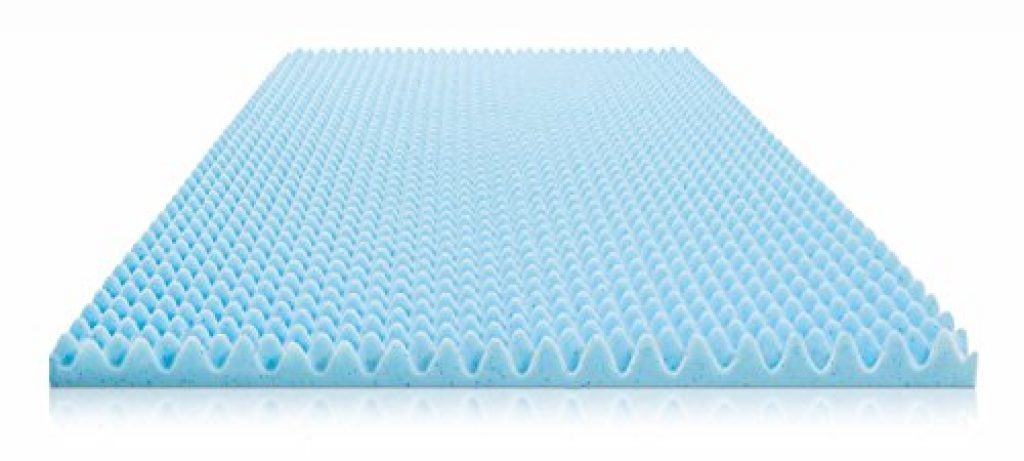
This type of foam was engineered to overcome traditional viscoelastic’s biggest problem, which is heat retention. The foam needs to absorb heat in order to be less viscous and more adapting, but this also means it will sleep hot.
To create a balance and increase heat dissipation, manufacturers started using cooling gels. In most cases, these gels are quite standard, but some producers took the industry a step further and created new substances that will increase the level of temperature regulation in the foam.
The gel can be disposed as randomly located beads through the surface, or it can be a thin but unitary layer, at the core of the sheet. Regardless of positioning, the purpose of the gel is to open up the cell structure of the foam and allow air to move through. This ventilates the bedding, and takes the heat away, keeping you dry and comfy all night long.
Air Cool
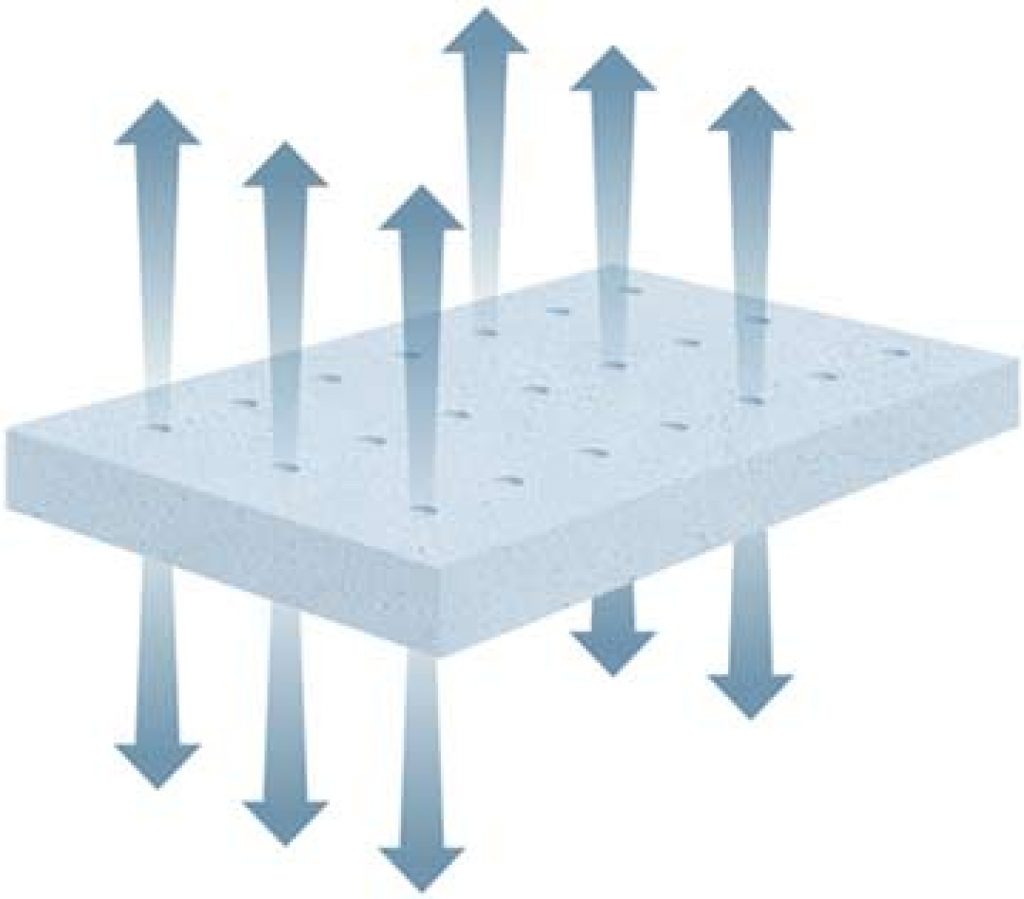
This technology is based on a combination of layers and it oftentimes includes gel memory foam and sheets of foam infused with other materials such as charcoal or copper. At the base of Air Cool foam stands the ingenuity of combining different densities, types, and shapes of foam in order to create a clear path for the airflow to keep going through the entire mattress unhindered.
So, in this case, each layer has its own purpose in driving the air through your bedding. The gel-infused sheets have the purpose of cooling the air down while other materials absorb humidity. Furthermore, some layers are shaped with channels or ventilation holes to allow the air to move freely.
Due to this combination, the foam will be faster to react and it may feel less soft. However, it will not sleep hot and you don’t run the risk of reducing the bed’s durability with too much cooling gel.
Open Cell Technology
This technology transfers the durability and flexibility of the mattress to the material, rather than basing it on some type of gas (as it happens with closed cell technology, where the responsiveness of the surface is based on air trapped in cells).
With open cell technology, the cells allow air to escape when you apply pressure on the bed. This compresses the surface, and creates the contouring effect we’ve been talking about. When you change position, and pressure is removed from the cells, they inflate right back up and air goes back in the cell. This happens because the walls of the cell are elastic and react to pressure.
As a result, the foam that implements this type of technology is better ventilated and responds faster than traditional viscoelastic.
Other (Organic, Plant Based, etc)
It is possible to find types of viscoelastic produced with plant-based elements, but no one was able to create a 100% organic memory foam bedding. The manmade elements will still represent a huge part of your mattress, and while the plant-based elements bring a touch of freshness, they don’t improve durability or any of the features.
If you are looking for an organic bed, that’s still foam-based, latex is the best choice. But you will lose all the contouring and softness of the traditional memory foam feel.
What Are Other Materials Besides Memory Foam Type
Latex
Latex can be organic or manmade, but if you are interested in getting the most out of your bed, we recommend the organic version. This is actually a type of foam, obtained from the sap of the rubber tree which is processed into a shape that will be supporting and contouring for you.
It’s important to only choose manufacturers that will collect the sap responsibly, without endangering the forests of the rubber tree. This way, you care for the environment and you get to sleep on a cruelty-free design.
Natural latex is bouncy, regulates temperature without the need of gels or other cooling systems, and is anti-bacterial. The fibers in such a mattress don’t allow for dust mites, bedbugs, bacteria, or fungi to take residence in your bed, which is extremely advantageous for people with allergies.
Overall, latex is bouncy, flexible, and does provide some contouring. Still, the surface is firmer and it doesn’t resemble memory foams at all.
Hybrid
This type of bedding is a combination of foams and coils, which brings you the greatest features of all the niches. The construction is usually simple, with two or three layers of foam on top and one layer of individually pocketed coils at the bottom.
Still, there are designs that feature two layers of coils, and the foams on top can also be a combination of latex and viscoelastic. Regardless of the situation, the general feel is bouncy and supportive due to the pushback action provided by the coils.
The cool thing about this type of bedding is that you can choose the type of firmness you need, and you can even customize it. And, while it’s true you won’t get as much motion isolation as you would with viscoelastic, the individually pocketed coils manage to do a pretty good job in this aspect.
In our opinion, hybrid designs are the next top-quality thing after memory foams!
Innerspring Coil
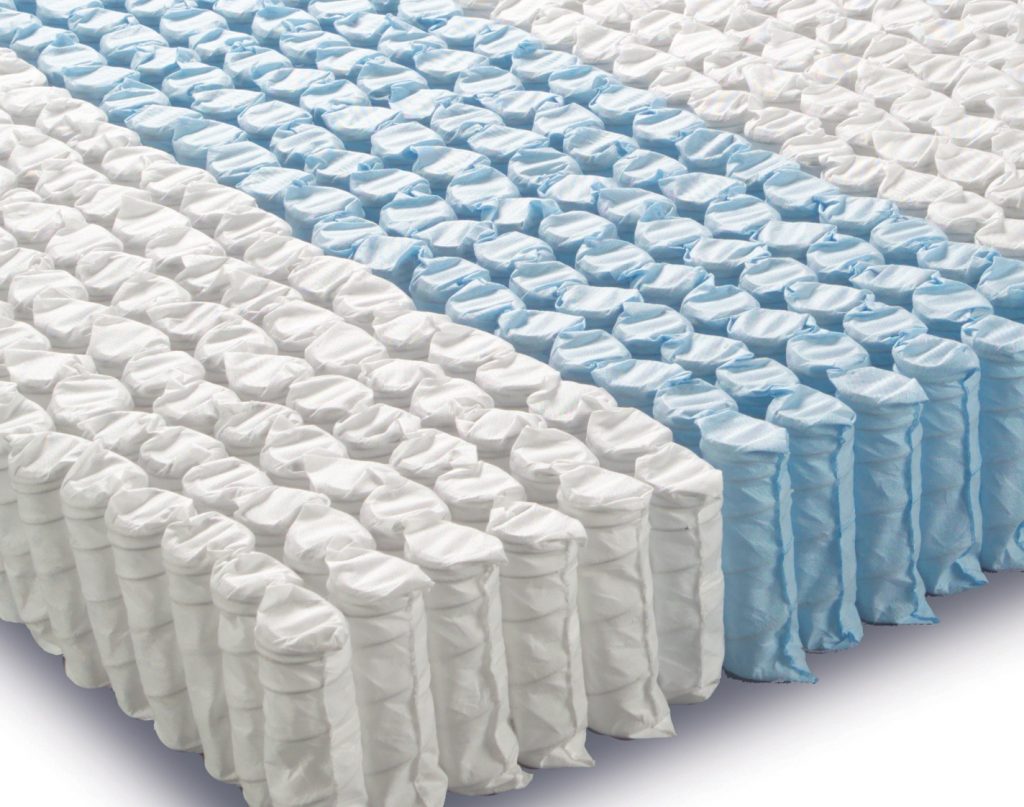
If you favor a springier surface, with more pushback effect than you’d get with a hybrid, then an innerspring is the best choice for you. These mattresses are supportive, bouncy, and quite flexible, but they’re not always great on the contouring part.
If you choose a design with interconnected coils, then the whole surface will move in sync. This also means that you will feel every move your partner makes, which may keep you awake.
On the other side, if you choose a pocketed springs design, you won’t have to worry that much about motion isolation. This type of bedding provides variable support, which is similar to the type of contouring offered by a memory foam bed (but with springs). Each coil will respond to pressure separately, so your spine will be kept aligned while some of the coils will give in a bit more to accommodate your heavy areas (hips and shoulders).
Waterbed
Waterbeds were extremely popular a while ago, but we believe their time has passed. First, they have a major flaw for people with cats, dogs, or sharp objects around the bedroom. And, if a waterbed starts leaking, there’s absolutely nothing you can do. Worse, if the leak is big enough, the water will come out pouring, inundating everything and everyone.
In terms of comfort, there will be no pressure points, since you’re basically sleeping on water. Still, the back support is totally wrong and the water inside is not temperature regulated. If it’s cold outside and you leave the window open, your butt will freeze. On the other hand, if it’s a hot summer, the water will get hot and you’ll enjoy a very toasty sleep experience.
Overall, these types of beds are perfect for fun and sex, but they are not that good for actually sleeping for long periods of time.
Airbed
The airbed is basically a waterbed, but filled with air. Just like with the aforementioned bed, you won’t get any pressure points, but if the valve is leaking, you may end up with a deflated mattress by morning.
When the valve is working correctly, airbeds are quite nice because they allow you to set the firmness exactly how you want it. Not to mention, they’re easy to move, you can take them camping, and you can simply store them away.
Now, besides the risk of puncture, there is also the matter of air temperature. The air inside the mattress can very easily get hot, if it’s hot outside, but more often than not, it gets pretty cold. If the bed is situated on the ground, without any isolation, the air will get quite cold, and your butt will freeze during the night.
Overall, airbeds are better than waterbeds, in terms of support and durability, but we wouldn’t recommend them for a steady arrangement.
Top Quality Memory Foam Traits
Softness
Softness is usually 5 or less on a scale of 1 to 10, with 10 being the firmest. Now, for memory foams, the firmness is established by its density, which we’ll discuss lower in this section.
When you’re choosing a viscoelastic bed, it’s important to understand that its true feel is when you’ve been sleeping on it for a while. This way, the mattress has time to take in your body heat and its viscosity will be reduced.
But, given you don’t have the chance to test the mattress before actually buying it, if you want a soft surface it’s best to choose one that has 3 pounds per cubic foot density or lower. This type of foam will give in faster under pressure, so the level of sinkage and contouring will be more pronounced.
You should also keep in mind that low density foam is less responsive, so a soft design may come with the ‘stuck in quicksand’ sensation many people dread.
Firmness

Now, firmness starts from 5 and goes up to 10, on the 1 – 10 scale, but the interval between 5 and 6.5 is actually a medium level (not too soft, not too firm). Actually, most manufacturers try to create this type of surface, to make sure most people are pleased with their products.
So, whenever you find only one type of mattress in a producer’s offer, you can be sure that the feel will be a medium. This translates as 4 to 5 pounds per cubic foot in terms of viscoelastic density, and this also brings good durability, comfort and contouring.
Now, if you want a firm design, you should consider getting anything over 6 pounds per cubic foot, which is also known in the industry as HD foam (from high-density). This type of material is extremely durable, it provides good back support, and is known to improve circulation. It is usually placed at the bottom of the bed, as the base, and it supports all the layers on top.
Thickness
This feature is quite relative, as it depends on the number of layers inside. However, most mattresses (regardless of construction) are between 6 and 14 inches in thickness.
As a rule of thumb, the thicker the mattress, the softer the surface will feel. Still, this doesn’t mean that a thinner mattress will lose the well-acclaimed memory foams properties!
In most cases, even if the mattress is an all viscoelastic design, there will be several layers inside. The greatest case scenario has a combination of densities, starting with low density on top, moving to medium and ending with firm. This way, the surface will be durable, contouring, but also supportive and responsive.
If you are purchasing a hybrid design, chances are that the top layer(s) will be memory foams, to provide the best possible combination.
Density
This feature decides the responsiveness, firmness, and durability of your viscoelastic bed so you should be extremely well-familiarized with it.
The density is expressed in pounds per cubic foot and it varies on a scale from 1 to 6+, like this:
- 1 – 3 – Low density.
- 5 – 5.5 – Medium Density.
- 6+ – High Density.
The density will also determine the weight of your bed (the denser the foam, the heavier the entire product will be), and the final price. HD foam is more expensive than low quality foam. This is also one of the reasons why you should never jump at cheap memory mattresses that look great, if you don’t want a soft design.
Most people prefer medium density because it feels just right. The surface is not too soft, but not too firm either, the durability is good, and the price is affordable. Still, if you like a firmer design or you suffer from severe back pain HD foam is the best choice for you. This type of foam is used in medical equipment and beds because of its amazing properties.
Warranty

Warranty is important because it shows how much trust the manufacturer puts in their products. After all, there’s a huge difference between a product with 5-years warranty and one with 20, right?
Still, it’s not just the time they are willing to stand behind their product that matters. You should also read about the coverage. This means the exact parts of the mattress that are covered by the warranty.
For instance, some producers will only cover the inner layers, not the cover. Or some will only accept to repair/change the product if a certain level indentation showed up in the foam. This is why it’s very important to read the warranty agreement and the conditions under which it is applied.
In our experience, most mattresses will have to be changed after 8 to 10 years, so a warranty of 20 years won’t really be helpful if the bed is not fully covered.
Toxic Off-Gassing and VOCs
Off-gassing is usually felt when you first unbox/unwrap your memory mattress and you get that fresh paint smell. This is produced by the breakdown of volatile organic compounds (or VOCs) used to make the foam or adhesives.
These VOCs can include a series of chemical substances such as chlorofluorocarbons (CFCs), formaldehyde, benzene, methylene chloride, toluene, and/or naphthalene. We know this does sound like a mixture for a weird compound, but none of the studies done on this topic could prove that VOCs are toxic.
Yes, the smell can be annoying and quite irritating for some people, but it is not harmful. And, once the smell goes away, sleeping on the mattress will not have any negative effects on your health.
Now, due to complaints received from people who don’t really enjoy the idea of such a chemical cocktail, there is a way to make sure your mattress was exposed to less such substances. For this, just make sure the product you’re purchasing was vetted under the CertiPUR-US certification process.
5 Best Quality Memory Foam Mattress Reviews
Nectar (Highest Rated for the Value)
Features:
- Works with all types of frames
- Tencel cover for improved breathability
- CertiPUR-US foams
Our Rating: 9.6/10
Nectar features a combination of four types of memory foams, starting with two different layers of gel foam, and ending with a full-foam base that’s durable and supportive. In between, there is a sheet of Adaptive Hi Core Memory Foam that keeps you from sinking into the base. This layer is designed to provide amazing back support and keeps the contouring provided by the first two layers under control.
The bed is a medium-firm feel and has good motion isolation. It’s also breathable and the cover is soft to touch. But it’s not just the construction that recommends this product! It’s also the 365-days trial period and Forever warranty with incredible coverage. This shows the producer is willing to support their products for as long as it takes.
Considering these features and the affordable price, Nectar is indeed the product that brings the best bang for your buck.
Want to learn more? Head over to our in-depth bed analysis.
Bear (Ideal for Eco-Friendly People)
Features:
- Sleeps cool
- Medium level firmness
- Graphite-Gel Memory foam
Our Rating: 9.4/10
The fight for a cleaner environment will never be over, but Bear mattress is an active participant as they tried to create an eco-friendly viscoelastic bed. For this, they use only CertiPUR-US foams and water-based glue to avoid any VOCs and to reduce off-gassing to an absolute minimum. As a result, the mattress will have little to no smell, and you will not have to wait for 24h before using the bed.
The product is also recommended for people in recovery after an injury. The cover is woven with Celliant’s FDA Determined Infrared Yarn Technology, which is known to promote overall well-being and faster recovery.
Finally, the surface will sleep cool, due to the graphite-gel infusions. According to the producer, this surface is seven times better cooled and ventilated than a traditional memory foam solution.
So, if you’re looking for an eco-friendly memory foam mattress, this product may just be the top-quality choice for your needs.
Casper (Terrific for Every Position Sleepers)
Features:
- Easy to install
- Support designed for your needs
- Pressure-relieving foam
Our Rating: 9.3/10
Casper is a well-established name in the industry and one that will bring you the bed rolled up to your doorstep. They are part of the bed-in-a-box trend and offer 10 years warranty and 100 nights sleep trial. Also, the foams used to make their mattresses are CertiPUR-US certified and the products are designed and assembled in the country.
The Casper is their most popular design, featuring a medium-firm feel and zoned support. It’s also one of the few mattresses that can truly deliver the traditional memory foam feeling without overheating. The surface is well-ventilated due to the open cell technology and the mid-layer is divided into three different zones of firmness.
This construction makes the Casper one of the best beds for any type of sleeper. Because it is firm under your hips and core, and soft under your shoulders, the design will keep your spine aligned regardless of your position. Furthermore, the mattress is affordable, which is impressive considering the plethora of cool features.
For much more in-depth features and tests, see our complete review here.
Loom & Leaf (Amazing Luxurious Feel)
Features:
- Ultra-luxury mattress
- 5 lb. memory foam with CertiPUR-US certification
- Affordable price
Our Rating: 9.1/10
Loom & Leaf is the luxury product from Saatva, one of the most famous online brands in the mattress niche.
The mattress promises uncompromised comfort on a memory foam mattress, and they actually deliver! With organic cotton in the luxurious, plush cover, and an inner-structure that’s more than impressive, this design is worthy of your attention.
They start with a layer of gel that will keep you cool and cozy, move on to a 5lb layer of eco-friendly foam that is just right for both contouring and support, and end up with a final layer of foam that’s specially engineered to allow airflow.
All the foams are sourced in the US, which allows the manufacturer to check if the materials are indeed of the best quality. Overall, this is a luxury product that in brick and mortar stores would cost five times the price it promotes on the site. So, if you’re looking for the highest possible quality, Leaf & Loom is just right!
Ultimate Dreams Supreme 12″ Gel Memory Foam (Best for the Money)
Features:
- Great for all sleeping positions
- Medium firmness level
- Medium density memory foams
Our Rating: 8.9/10
If you’re in the market for a budget mattress, the Dream Supreme is one of the ideal choices. It is 12 inches thick, and features good back support and pressure relief. This is due to the types of foam used for the inner-structure:
- One layer of gel memory material (4lb density)
- One layer of 4lb memory material
The first layer is in charge of softness, contouring and cooling, while the second one serves as the base providing durability and firmness. When combined, the two layers create a comforting surface, with good pressure relief at an impressive price.
Dream Supreme may be a budget choice, but the manufacturer did not skimp on quality! The foam used is CertiPUR-US certified, with low VOC, and the mattress is made in the USA for a better manufacturing process.
Our Final Thoughts
Viscoelastic is one of the highest quality materials ever created in term of comfort and support. Of course, it has its flaws, but with a bit of ingenuity, manufacturers managed to overcome most of them. Better yet, they managed to create better designs that feature all the good characteristics of the memory foams.
As long as you follow our guidelines on how to choose the best type of foam for your needs and understand the different technologies used for cooling, there is no way you could choose the wrong product!
Still, if you’re not interested in learning about memory foams and its features, we put together a top five best beds on the market that can meet everyone’s needs. So take a look and choose the one that fits your requirements!
We also know that memory foams are not for everyone, but if you’ve never tried it, you shouldn’t ignore it. As you can see from our article, it does take a bit to get used to it, but once this happens, the contouring, the softness, and the wonderful flexibility may impress you beyond measure. After all, there must be a reason why so many people favor this material!


